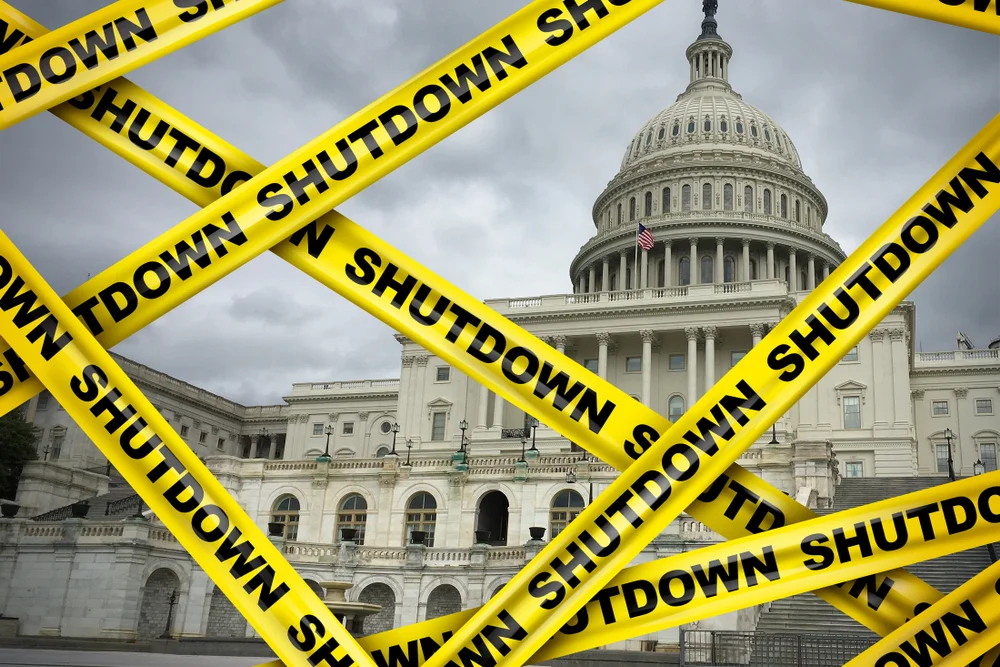
The U.S. government officially shut down on Oct. 1, marking the 21st closure since 1976 after the Senate failed to pass a continuing resolution late Tuesday.
With no stopgap deal in place, funding expired at midnight, forcing the furlough of hundreds of thousands of federal workers and halting many government operations.
While political rhetoric intensifies in Washington, market implications may be more nuanced—and in some cases, even bullish.
What Exactly Is A Government Shutdown?
A government shutdown occurs when Congress fails to approve funding for federal agencies, forcing them to suspend operations and furlough non-essential workers.
Essential services, such as military operations, border control, air traffic, and Treasury payments, continue under contingency planning.
During a shutdown, hundreds of thousands of federal employees work without pay or are temporarily sent home until funding resumes.
Non-essential services such as national parks, visa processing, and routine regulatory activities typically slow down or halt entirely, amplifying disruptions for businesses and citizens alike.
According to Goldman Sachs economists Alec Phillips and Ronnie Walker, the shutdown is likely to furlough around 900,000 federal employees, or approximately 40% of the workforce, resulting in delayed paychecks and interrupted services.
“Shutdowns are not the same as defaults, but they send a damaging signal about political dysfunction in the world’s largest economy,” said Nigel Green, CEO of deVere Group, in an emailed comment.
How Long Could It Last?
Since the enactment of the 1974 Congressional Budget and Impoundment Control Act, the U.S. has experienced 21 shutdowns. Most have lasted under a week, but five have extended more than 10 days.
The longest, from December 22, 2018, to January 25, 2019, lasted 34 days, although it was only a partial shutdown.
On average, shutdowns last eight days, but only four have resulted in fully closed operations for longer than one business day. In the five longest shutdowns, the political party perceived to have caused the impasse often suffered electoral consequences—though outcomes vary depending on concurrent events, such as the 2014 ACA rollout, which may have blunted backlash.
According to Kim Wallace, analyst at 22V Research, conversations on Capitol Hill suggest the shutdown “could drag into or beyond mid-October,” given congressional scheduling and entrenched partisan dynamics.
How Could The Fed React To Missing Economic Data?
The shutdown halts the release of critical economic data from federal agencies, including the monthly jobs report and inflation figures from the Bureau of Labor Statistics.
While data already collected will be published once the government reopens, any shutdown that lasts through mid-October risks disrupting new data collection altogether.
That creates a temporary information vacuum for policymakers at the Federal Reserve, who may be forced to rely on outdated reports or turn to private-sector alternatives.
“The Federal Reserve emphasized the September move as an insurance cut. A shutdown would likely leave the central bank in a fog about the labor market, fueling support for an October cut rather than risk falling behind and having to cut more later,” Ryan Sweet, chief U.S. economist at Oxford Economics, said.
How Are Markets Reacting? History Shows No Panic
Despite the media frenzy, financial markets showed no panic during shutdowns.
The S&P 500, as tracked by the Vanguard S&P 500 ETF (NYSE:VOO), has historically remained flat to mildly positive during periods of shutdowns.
Jeff Buchbinder, chief equity strategist at LPL Financial, said that since 1976, the S&P 500 has posted gains more often than losses, with the worst drawdown being just 2.2%.
During the 2013 shutdown, for instance, the index rose 3.1% over 16 days, indicating that investors are often more focused on earnings and macroeconomic data than on temporary political impasses.
The 2018-2019 government shutdown saw the S&P 500 surge 11.92%.
Read also: Think Government Shutdowns Crash Stocks? The S&P 500 Has Other Plans
Treasuries: Stability, Not Stress
U.S. Treasuries, central to global fixed-income markets, continue to function without disruption.
The Treasury Department continues to conduct auctions and pay interest, as these operations are deemed essential. Shutdowns affect non-discretionary spending, not debt management.
Historical data show that 10-year yields typically declined slightly during shutdowns.
Commodities: Haven Demands Continue, Oil May Stumble
According to Colin Fenton, analyst at 22V Research, the closure is prompting a modest but clear rotation into precious metals like gold, silver and platinum, while pressuring oil and energy stocks.
“Shutdown means incremental bid toward safe havens and incremental fade of upstream oil,” he said, noting that gasoline and diesel demand may fall due to furloughed government employees.
Fenton added, “Sentiment is clearly gunning to take out the all-time high in silver,” which stands at $49.82, set on April 25, 2011.
Read now:
Jobs Shock: Biggest Loss In Over 2 Years And Fed May Cut Again
Photo: Shutterstock



